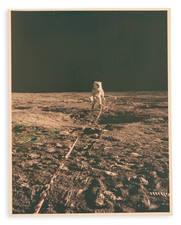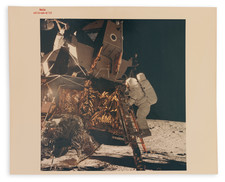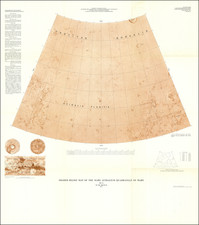Apollo 11, 12, and 14 Traverses, a triptych map, delineates the journey of three pivotal Apollo missions on the lunar surface. This unified sheet places Apollo 11 at its zenith, followed by Apollo 12 at the central left and Apollo 14 anchoring the layout. Prepared by the U.S. Geological Survey and subsequently published by the Defense Mapping Agency on behalf of the National Aeronautics and Space Administration (NASA), this map offers a scientific and systematic record of the traverses undertaken during these missions.
The second half of the 20th century was a period of intense competition and innovation in space exploration, culminating in the moon landings of the Apollo program. These moon missions, led by NASA, were not merely about landing humans on the lunar surface and returning them safely, but also about scientific exploration and data collection. These mapped traverses are a testament to the rigorous planning, training, and execution that went into every phase of these missions.
Integral to the maps is a legend and explanation detailing the missions' key aspects. "Landing site" marks the point of arrival of the lunar modules, while "Traverse station" and "Traverse track" trace the routes and stops made by the astronauts during their extra-vehicular activities. The terms provided elucidate the equipment and experiments conducted. Notably, the "ALSEP Apollo Lunar Surface Experiments Package" references the suite of scientific instruments dispatched on the moon, and "EVA" denotes the moments when astronauts exited their crafts to explore and conduct experiments on the lunar surface.
The details of craters, a prominent feature of the moon's surface, are rendered with precision. The names accompanying these features are sanctioned by the International Astronomical Union, underscoring the global recognition and standardization of these lunar landmarks.
Beyond its scientific import, this map is an invaluable record of one of humanity's most audacious feats. It encapsulates the ambition, expertise, and collaborative spirit of an era that sought to expand our understanding of the universe by venturing beyond our home planet.
Apollo 14 was the third Apollo mission to reach the moon and the first immediately following the disastrous Apollo 13 mission. This mission targeted the same area as the ill-fated previous one: the Fra Mauro highlands. This was the first mission to land in lunar highlands and, as such, provided new scientific insights.
The mission was conducted by Alan Shephard, Edgar Mitchell, and Stuart Roosa, the first two of which landed on the moon while the third remained in lunar orbit. The presence of Alan Shephard in a space crew is notable as he was the first American in space. He had been grounded for several years due to inner ear problems and had been cleared to fly again two years prior to this 1971 mission. Upon landing, his first words were "and it's been a long way, but we're here."
This mission was the last of the "H-missions," two-day lunar missions. The final three lunar missions would be three-day ventures, involving slightly more sophisticated technology. During this mission, Shepherd and Mitchell ended up spending 33.5 hours on the moon, 9.5 of which outside the lander. In addition to scientific pursuits, Shepherd shot some golf with a makeshift golf club and two balls he had brought from earth, recorded in a video that still captivates the world.
Targeting the highlands was useful as the previous two missions had both landed in "mares," expansive young basaltic planes. Highlands appeared very different to astronomers, but their exact histories were unknown. The Fra Mauro highlands were targeted due to the presence of the Cone Crater, a recent impact that provided a natural borehole.
The samples collected by this mission were of particular geological importance for the insights they provided on meteoric history and surface flows of the moon. The samples were mostly breccia, a type of rock that can be produced by meteoritic impacts, useful for showing Fra Mauro was formed as a result of impact ejecta. The rocks collected in this area were substantially older than those collected in the mare areas of previous missions. These samples helped to put a lower bound on the age of the moon, much older than the age suggested measuring lunar retreat.
One of the samples collected by this rock, nicknamed "Big Bertha," was later shown to be a likely earth-sourced meteorite. This is determined from the presence of evolved minerals such as quartz and feldspar, in addition to the isotopic signatures of zircons. Dated to approximately four billion years, this ranks as one of the oldest terrestrial rocks, slightly younger than the 4.28 billion-year-old date given for the formation of the protoliths for some Canadian metamorphic rocks. Crucially, this rock has not been altered to such a high extent. This provides scientists with extensive information about the early earth, complementing the information gained from studying terrestrial rocks. If life already existed by the time this meteorite was ejected from the earth, it would have been able to survive the short moonward journey and would be an early short-lived example of extraterrestrial life.
Apollo 10 was a May 1969 mission which acted as a practice run for the Apollo 11 mission. The mission was set up in the same way as Apollo 11 would be two months later, with a crew of two in a lunar module descending near to the surface of the moon while the main capsule remained in orbit. As such, it was the first fully manned Apollo mission to orbit the moon and the second manned orbit of the moon after Apollo 8. NASA refers to the mission as "an actual crewed landing, except [for] the landing."
The mission was manned by John Young, Thomas Stafford, and Gene Cernan, with the latter two commanding the lunar module while the former stayed in the command module. All three of them would return in later Apollo missions despite some issues with NASA management which highlighted the politics of the program.
NASA was worried that the astronauts would attempt to land on the moon, and, as such, they decided to short fuel the lunar module. The module had approximately ten percent less fuel than the Apollo 11 mission, just enough to complete the mission. Had they attempted to land, they would be left unable to return to the command module. The astronauts arrived within 8.4 kilometers of the moon and collected important information regarding the moon's gravitational field, allowing for calibration of the Apollo 11 landing system.
This mission was part of an ongoing collaboration between Charles Schultz and NASA. After trying to rebuild their public image in the wake of the Apollo 1 disaster, NASA chose Snoopy as their safety mascot. Apollo 10's lunar module was named Snoopy, and its command module Charlie Brown.
Apollo 12 was the sixth crewed flight in the United States Apollo program and the second to land on the Moon. It was launched on November 14, 1969, from the Kennedy Space Center, Florida, four months after Apollo 11. Commander Charles "Pete" Conrad and Apollo Lunar Module Pilot Alan L. Bean performed just over one day and seven hours of lunar surface activity while Command Module Pilot Richard F. Gordon remained in lunar orbit. The landing site for the mission was located in the southeastern portion of the Ocean of Storms.












![[Ion Powered Spacecraft Traveling To Mars]](https://storage.googleapis.com/raremaps/img/small/83629.jpg)

![[Moon rock or boulder from the Apollo 16 mission, numbered AS16-108-17694.]](https://storage.googleapis.com/raremaps/img/small/93459.jpg)